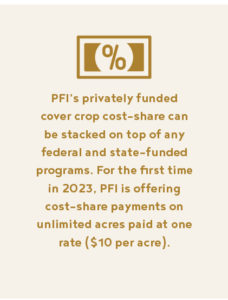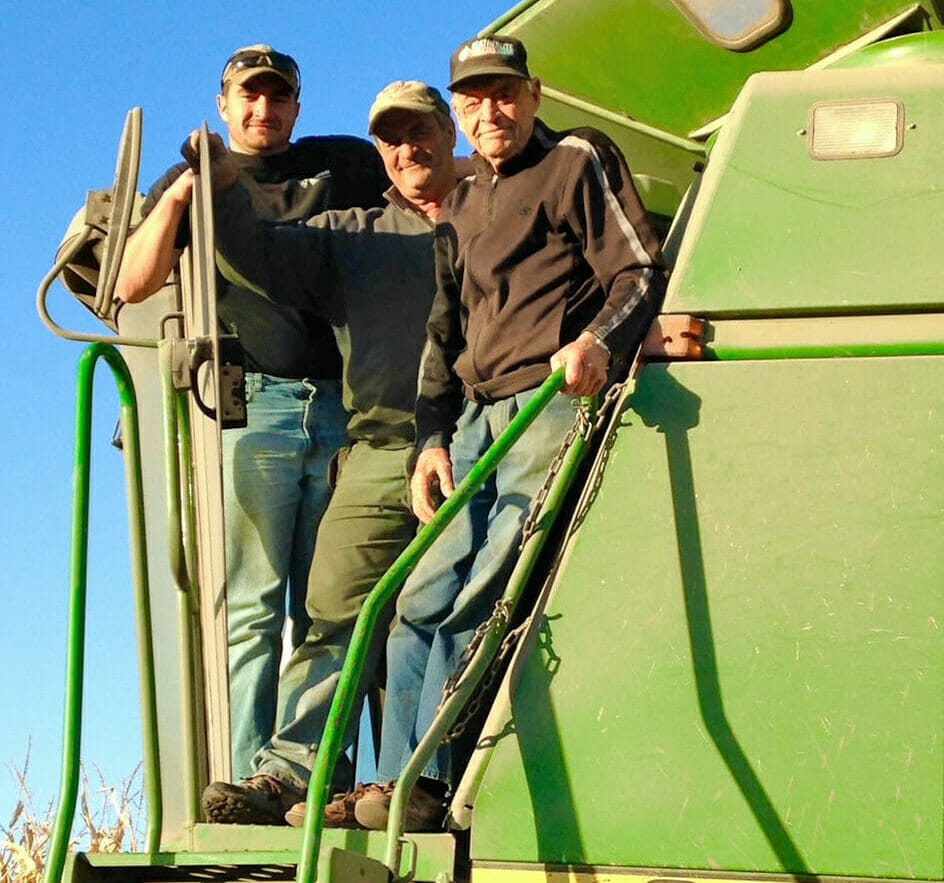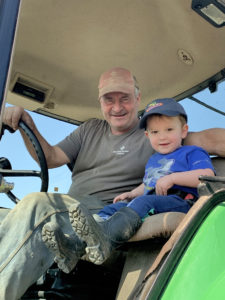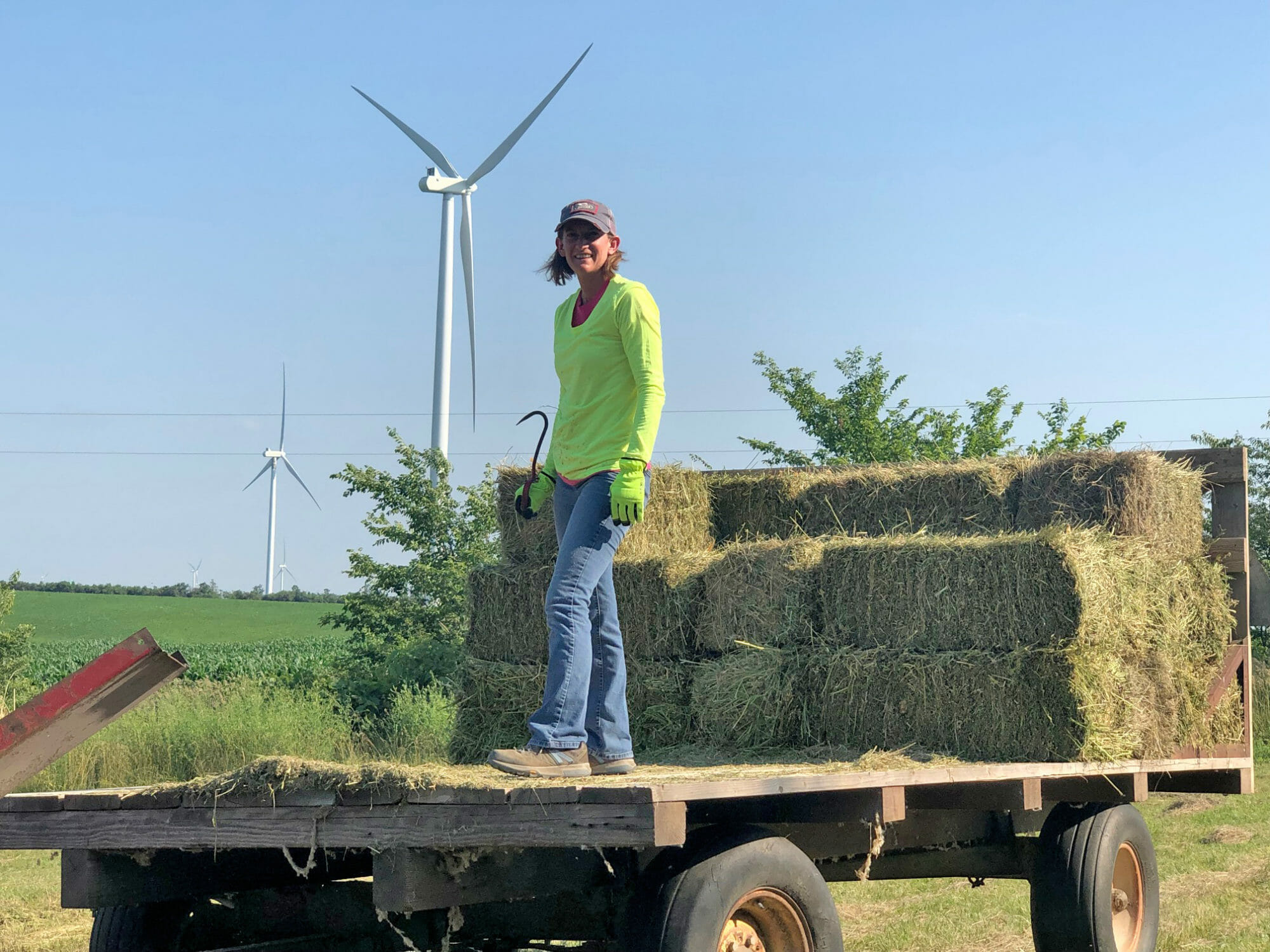Covering Cover Crops
In Malcolm, Iowa, sits the Van Arkel family farm. Dave Van Arkel and his son, Zach, farm 2,000 acres of corn and soybeans, with additional land in the Conservation Reserve Program. They also have grass waterways, a conservation practice where grass is seeded in areas of concentrated water flow to conduct water off the landscape, using grass to protect the soil; a timber stand; and Zach has some of his own acres where he and his wife, Grace, raise sheep.
Preserving soil health has long been important to the family – both keeping soil in place and improving soil health overall. In the 1970s, Dave’s father, Jim, built a terrace after fretting about soil erosion. The family has since added more terraces, and they work after harvest to lay their own tiling network. In line with their soil health goals, Dave and Zach have been steadily working towards full no-till, gradually adding more no-tilled acres when they can, and they cover crop with cereal rye ahead of soybeans.
“We started with cover crops in 2015 when I came back to the farm,” Zach says, “and we now put covers on every acre going into beans.”
Cost-share programs proved vital in helping the family get started with covers. They first used state funds – and then found more funding through Practical Farmers of Iowa. “I would have drug my feet a lot harder had it not been for the cost-share,” Dave says. “Zach wanted to do cover crops and the cost-share really helped.”
Connecting Through Cost-Share
 The Van Arkels were first introduced to Practical Farmers in 2015 through a gift membership. But it was PFI’s cover crop cost-share program that got them more involved – in 2018, Dave and Zach attended a PFI meeting to learn more about it, and while there, they decided to sign up. Though the family had started using covers three years earlier, they credit state and private cost-share programs like PFI’s with helping make cover crops work financially as they further integrate covers on their farm.
The Van Arkels were first introduced to Practical Farmers in 2015 through a gift membership. But it was PFI’s cover crop cost-share program that got them more involved – in 2018, Dave and Zach attended a PFI meeting to learn more about it, and while there, they decided to sign up. Though the family had started using covers three years earlier, they credit state and private cost-share programs like PFI’s with helping make cover crops work financially as they further integrate covers on their farm.
The Van Arkels’ positive experience with PFI’s cost-share program led to further engagement. In 2022, Dave and Zach volunteered for shifts at PFI’s Farm Progress Show booth to talk with farmers from around the country about cover crops. Zach says he enjoyed hearing other farmers’ experiences. “I like farming because there isn’t always a completely right answer,” he says. “We are just trying to do the best with what we have.”
Outside of PFI, Dave and Zach have these kinds of conversations with neighbors, and they pay attention to what farmers are saying about cover crops. They think the practice is gaining ground – more of their neighbors, for instance, are asking questions about their cover crops. But they admit barriers still remain to getting more covers on more acres.
“People don’t seem ready to take the full risk,” Zach says. “People will ask about [cover crops], and if they have livestock, they should definitely go for it. But economically, it is harder to convince just row crop people.” He and his dad agree that landowners need to be engaged on cover crops and made aware of cost-share programs that can offset costs. They also think landowners need to be to better equipped to engage in conversations with their tenants about incorporating cover crops.
Zach connects with landowners and farmers alike in the family’s farm newsletter he shares twice a year. In addition to chronicling his return to the farm and the growth of their family and business, Zach includes a crop report and a section he calls the “conservation corner,” where he addresses issues like how his family is experimenting with cover crops on the farm. Dozens of full-color photos help illustrate their efforts.
Pacing Cover Crop Progress
With their own sheep, Zach and Grace graze their flock of 100 ewes on the cereal rye cover crop whenever they get the chance. “Grazing [cover crops] makes a lot of sense if you have livestock,” Zach says. “It helps us make cover crops work financially.” However, the Van Arkels are still learning exactly how cover crops balance out financially on their row crop ground without cost-share incentives.
One challenge is that cover crops add another layer of management. So far, Dave and Zach have tried to keep things simple, which has allowed them to seed covers affordably and quickly. They typically broadcast their cover crop with fertilizer in the fall, which is a pass through the field they would’ve had to make anyway. “If someone wants to try cover crops, it is so simple to just go out and broadcast it,” Dave says. “We are making the same number of herbicide passes, so it doesn’t really cost us outside of seed using this practice.”
While they feel comfortable with cover crops before beans, seeding cover crops before corn hasn’t worked out for them yet. But as they refine their experience, they plan to revisit that practice. First, though, they need to address the factors that currently make it too risky. To make cover crops before corn workable, Dave and Zach say they need more biomass, fewer input costs and less risk at planting.
“We’re getting better weed control, water-holding capacity and erosion control ahead of beans,” Zach says. He and Dave hope that if they experiment with drilling rye in the fall ahead of corn, as opposed to broadcasting it, they might be able to get enough growth from the cover to make the soil health benefits outweigh the risk. “We’ve adapted,” Dave says. “We are planting more cover crops. We started slow and now we are really gung-ho. We have every acre covered going to beans and now we want to try getting started on bean ground headed to corn.”
As they work toward that goal, they are assessing their options, looking at different cover crop species ahead of corn and talking with people about different cover crop mixes “Right now, we are happy with rye and we are confident in rye,” Zach says. “We are entertaining what might be beneficial in another situation.”
As they head into their eighth year using cover crops, Dave and Zach have no doubts about the conservation benefits of cover crops. They’ve learned a lot, and are committed to doing what it takes to make cover crops work as seamlessly with their financial goals as with their farm’s conservation goals. “We are looking for ways to diversify,” Zach says. “Just adding the cover is a way to diversify. We are looking at opportunities with livestock for better return per acre, and small grains.”
Diversification spreads out risk, and cost-share programs have offered Dave and Zach an important safety net to further reduce that financial risk. Freed from the burden of figuring out how to make cover crops profitable from the get-go, the programs have ultimately allowed them to dedicate time – the most elusive resource of all – to experimenting, pacing their progress and figuring out what works for them on their farm.



